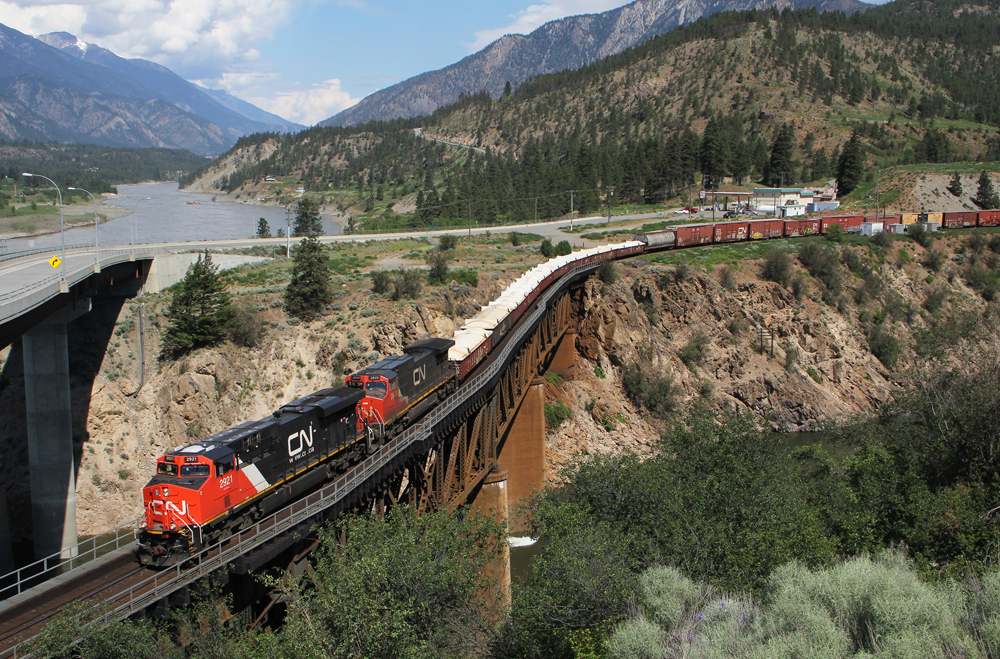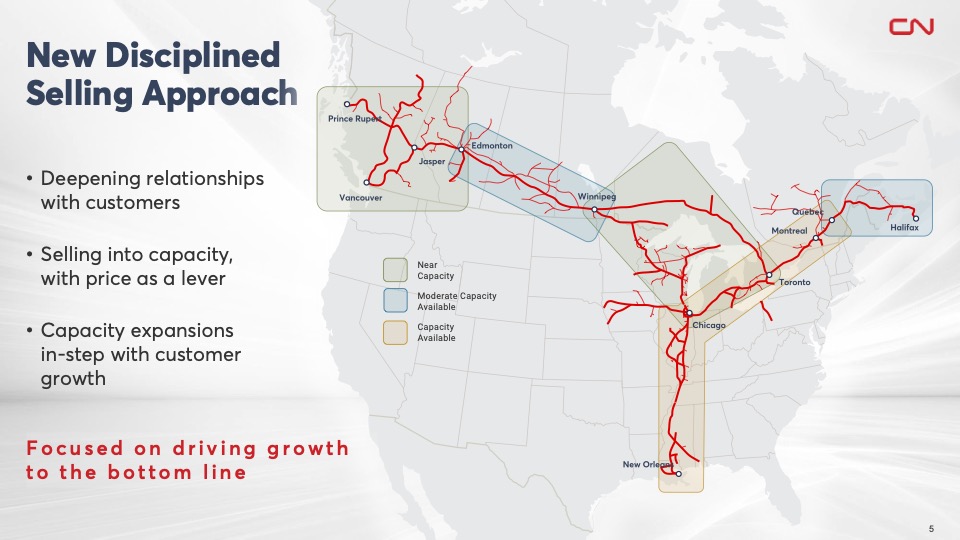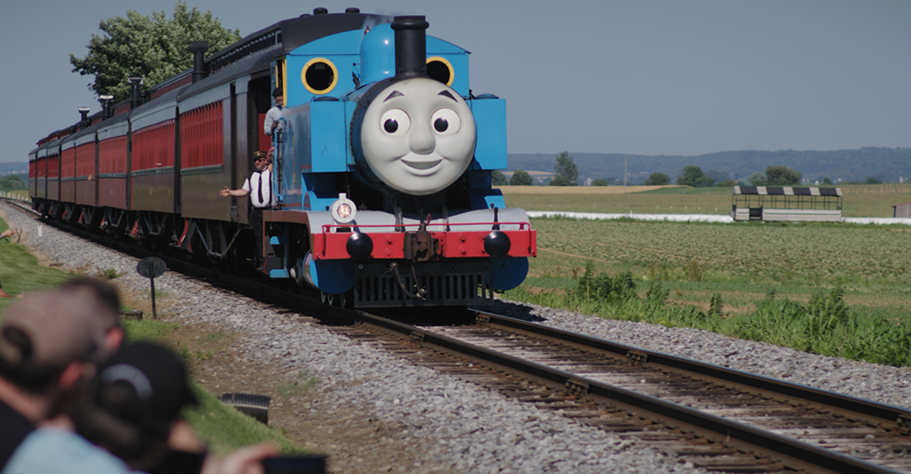 A westbound Canadian National train crosses the Thompson River on the CN main at Lytton, British Columbia, in May 2015. CN will continue to add capacity west of Edmonton, Alberta, to support traffic growth. Alex Mayes
A westbound Canadian National train crosses the Thompson River on the CN main at Lytton, British Columbia, in May 2015. CN will continue to add capacity west of Edmonton, Alberta, to support traffic growth. Alex Mayes
CHICAGO — During an investor day presentation today, Canadian National touted its operational improvements over the past year and said its faster, more fluid network has created capacity that its marketing team can sell to propel profitable volume growth.
“CN isn’t just back. I think we’re better,” CEO Tracy Robinson says.
CN moved away from a long train strategy last year after Robinson became CEO. The new operating plan, implemented beginning in April 2022, focuses on running to schedule, which has improved terminal dwell, average train speed, and the percentage of cars that make their connections. The result: Customer service has improved dramatically and car velocity is up 30%, Robinson says.
“We will drive volume growth that exceeds the pace of the economic growth on the continent into the future,” Robinson says. “The railroad’s humming, it’s working well, we’re excited about the growth ahead.”
Executives outlined carload growth projects across CN’s Canadian network, including bulk commodities such as grain, potash, and coal; renewable energy projects; natural gas liquids; fuel distribution in Ontario; new supply chains built around electric vehicles; and natural resource growth in northern British Columbia.
CN’s also expecting strong international intermodal growth from Vancouver and Prince Rupert, British Columbia; Halifax and Saint John in Atlantic Canada; and Mobile, Ala., and New Orleans on the U.S. Gulf Coast, plus domestic cross-border growth in traffic between Mexico and Canada through its new joint service with Union Pacific and Ferromex.
CN projected carload growth of up to 375,000 loads by 2026 and intermodal growth of up to 520,000 containers. “It’s a big number: 800,000 to 900,000 carloads or units per year of growth by 2026 annually,” Chief Marketing Officer Doug MacDonald says.
To support growth initiatives, CN will increase its capital spending from $3.5 billion this year to $4 billion by 2026, partly to fund capacity projects in Western Canada, particularly west of Edmonton, Alberta. Last year CN spent $2.7 billion on capital projects.
“This growth is going to give us the opportunity to invest in our network to expand our capacity to build new services … and the key to all of it is to do it productively,” Robinson says.
CN executives sought to assure investors and analysts that it won’t get caught short of capacity like it did in 2017 and that the increased capital spending would be linked to specific customer contracts that include volume commitments.
CN coagulated in the summer of 2017 and into 2018 after the railway took on more grain, crude oil, frac sand, and intermodal traffic than it could handle. CN’s western network was overwhelmed for two years while the railway rushed to complete capacity expansion projects.
Now CN is taking a disciplined approach to growth and capacity.
Before CN will bring in new traffic, the marketing, operations, and finance teams make sure they know what capacity improvements might be required, what they’ll cost, as well as the financial returns of the new business and when it’s expected to materialize. “Nothing gets on this railroad if it doesn’t go through this process,” Robinson says.
CN sells into the capacity it has available, either on a train-by-train basis or on a corridor basis. “We don’t put the business on the property until the capacity is available,” Robinson says.
CN aims to bring the growth to its bottom line: The railway expects to increase earnings per share by 10% to 15% from 2024 to 2026, up from single-digit growth this year. It’s also shooting for a 15% to 7% return on invested capital over that period.
CN’s financial outlook did not include revenue figures. And there was no mention of the operating ratio, the efficiency metric that’s closely watched by investors and analysts.
An analyst asked Chief Operating Officer Ed Harris if there was an opportunity for operating-ratio improvement. “I don’t think about operating ratio at all … If we continue to do everything right, that number will take care of itself,” Harris says.













Running shorter trains on a schedule in order to grow the traffic? Isn’t that what the better run railroads all did prior to PSR? And didn’t it work rather well for them? Imagine how much disruption could have been avoided if they’d continued to do this. Hope this philosophy makes a comeback on other lines as well.
In a hypothetical world, if one were the sole owner of a railroad, would one rather earn $2.7 billion net income on $10 billion in revenue with a lower operating, or $3 billion net income on $12 billion in revenue with a slightly higher operating ratio?
It is about earnings per share, not the operating ratio. If having a slightly higher operating ratio means more crew starts because of more trains run which attracted more business than was possible under the pier operating ratio, as a shareholder that is the best option because of the higher total net income.
“CN moved away from a long train strategy last year after Robinson became CEO. The new operating plan, implemented beginning in April 2022, focuses on running to schedule, which has improved terminal dwell, average train speed, and the percentage of cars that make their connections. The result: Customer service has improved dramatically and car velocity is up 30%…”
This is what Hunter Harrison talked about when he first came out with PSR at Canadian National after experimenting with the concept at Illinois Central. Running trains to schedule and improving the metrics in the paragraph above. The whole idea was that by running trains on schedule, even if they were not as long, goods would be moved to customers regularly and freight car utilization and velocity would increase over time. It did advocate longer, more fluid trains consisting of pre-blocked sections of of freight cars per destinations but I don’t believe it advocated the super long trains we have now which have killed fluidity, nor the excessive pursuit of massive cuts that permeated the industry the last several years and left it unable to move the freight it had. I feel those were the tools of corporate officers who forgot the purpose of railroads – serving the customers needs and wants – in pursuit of lower and lower operating ratios to gain large bonuses and salaries which came at the expense of customers and the economy by plugging the system with trains that could go no where because the system was plugged. The railroads got greedy and their employees and the public paid for it in poor delivery, labor shortages and unsafe operating practices.
Trains published an article, written by Bill Stephens, about the best and worst parts of PSR in April of 2022. Its worth a re-read. I have linked it below.
https://www.trains.com/trn/train-basics/abcs-of-railroading/what-is-precision-scheduled-railroading/.
“I don’t think about operating ratio at all … If we continue to do everything right, that number will take care of itself,” Harris says.
Shortly after that comment was made, the paramedics were probably called in to revive the analyst who probably had a coronary event when he heard Mr. Harris utter those words.